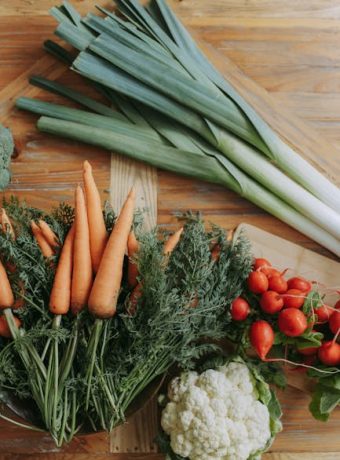Seasonal Fruits: Fall Picks for a Healthier You
Fall is a time of transformation, as the leaves change colors and temperatures begin to drop. It’s also a season when some of the most delicious and nutritious fruits come into their prime. Embracing these seasonal fruits can not only tantalize your taste buds but also boost your health. In this blog post, we explore the top fall fruits you should add to your diet for a healthier you.
The Importance of Eating Seasonal Fruits
Eating fruits that are in season has numerous benefits. Seasonal fruits are fresher, more flavorful, and more nutritious. They are often more affordable and environmentally friendly as well. According to the United States Department of Agriculture (USDA), consuming a variety of fruits and vegetables, especially those in season, can contribute to better health and reduce the risk of chronic diseases.
Top Fall Fruits and Their Health Benefits
1. Apples
Apples are synonymous with fall, and for good reason. They are packed with essential vitamins and minerals, including vitamin C and potassium. A medium apple contains about 95 calories and provides 4 grams of dietary fiber, which is beneficial for digestive health.
Fun Fact: There are over 7,500 varieties of apples worldwide, each with its unique taste and texture.
Health Benefits:
- Rich in antioxidants, which can help combat oxidative stress and reduce the risk of chronic diseases.
- High fiber content aids in weight management and improves gut health.
- May help lower cholesterol levels and support heart health.
2. Pears
Pears are another fall favorite, known for their sweet and juicy flavor. They are an excellent source of dietary fiber, vitamin C, and potassium. A medium pear contains about 101 calories and provides 6 grams of dietary fiber.
Health Benefits:
- High fiber content promotes digestive health and regular bowel movements.
- Rich in antioxidants that can help reduce inflammation and protect against certain diseases.
- May support heart health by improving blood pressure and cholesterol levels.
3. Pomegranates
Pomegranates are known for their vibrant red seeds and potent health benefits. They are rich in antioxidants, vitamins, and minerals. One pomegranate contains about 234 calories and provides a significant amount of vitamin C, vitamin K, and potassium.
Health Benefits:
- High antioxidant content helps reduce inflammation and protect against oxidative damage.
- May improve heart health by lowering blood pressure and cholesterol levels.
- Contains compounds that have anti-cancer properties.
4. Grapes
Grapes are a versatile and delicious fall fruit that comes in various colors, including red, green, and purple. They are a good source of vitamins C and K, as well as antioxidants like resveratrol. One cup of grapes contains about 104 calories and provides 1 gram of dietary fiber.
Health Benefits:
- Rich in antioxidants that can help protect against chronic diseases and support overall health.
- May improve heart health by reducing blood pressure and improving blood vessel function.
- Contains compounds that may have anti-cancer properties.
5. Cranberries
Cranberries are small, tart fruits that are often associated with fall and the holiday season. They are packed with vitamins, minerals, and antioxidants. One cup of raw cranberries contains about 46 calories and provides a good amount of vitamin C, vitamin E, and fiber.
Health Benefits:
- High antioxidant content helps reduce inflammation and protect against oxidative stress.
- May help prevent urinary tract infections (UTIs) by inhibiting the growth of harmful bacteria.
- Supports heart health by improving cholesterol levels and reducing blood pressure.
Ways to Incorporate Fall Fruits into Your Diet
Incorporating fall fruits into your diet is easy and can be done in a variety of ways. Here are some practical tips to help you enjoy these seasonal delights:
1. Add Them to Your Breakfast
Start your day with a nutritious boost by adding fall fruits to your breakfast. Top your oatmeal, yogurt, or cereal with sliced apples, pears, or grapes. You can also blend them into smoothies for a refreshing and healthy drink.
2. Snack on Them
Fall fruits make excellent snacks that are both delicious and nutritious. Keep a bowl of fresh apples, pears, or grapes on your kitchen counter for easy access. You can also pack them in your lunchbox for a convenient on-the-go snack.
3. Incorporate Them into Salads
Add a burst of flavor and nutrition to your salads by including fall fruits. Toss sliced apples, pears, or pomegranate seeds into your greens for a delightful contrast of textures and tastes. Drizzle with a light vinaigrette for a perfect fall salad.
4. Use Them in Baking
Fall fruits are perfect for baking. Make delicious apple pies, pear tarts, or cranberry muffins. The natural sweetness of these fruits can reduce the need for added sugars, making your baked goods healthier.
5. Make Homemade Sauces and Jams
Preserve the flavors of fall by making your own fruit sauces and jams. Cook down apples or cranberries with a bit of honey or maple syrup for a delicious and healthy spread. These can be used on toast, pancakes, or as a topping for yogurt.
Conclusion
Embracing seasonal fruits is a great way to enjoy the flavors of fall while boosting your health. Apples, pears, pomegranates, grapes, and cranberries are some of the top picks that offer a wealth of nutrients and health benefits. By incorporating these fruits into your diet, you can take advantage of their unique flavors and support your overall well-being.
Remember, eating a variety of fruits and vegetables is key to a balanced and healthy diet. So, head to your local farmers’ market or grocery store and stock up on these fall favorites. Your body and taste buds will thank you!



